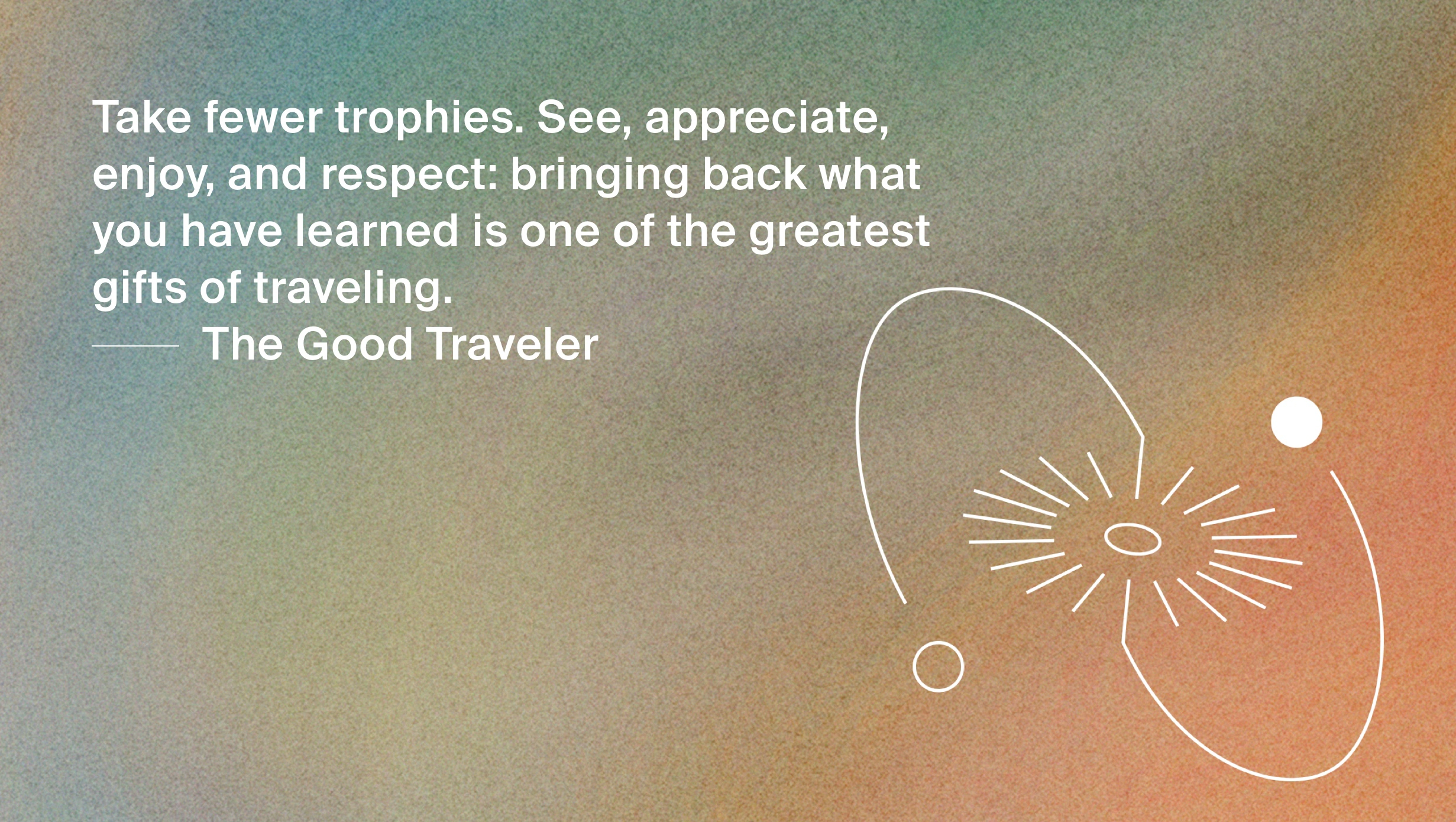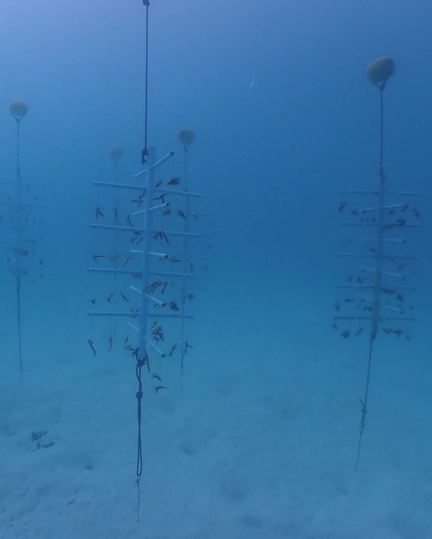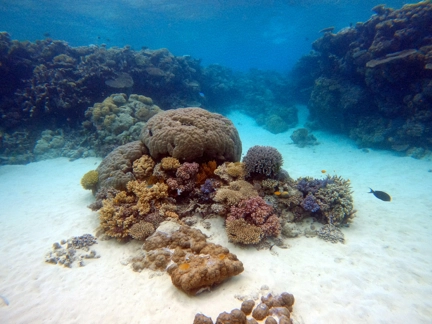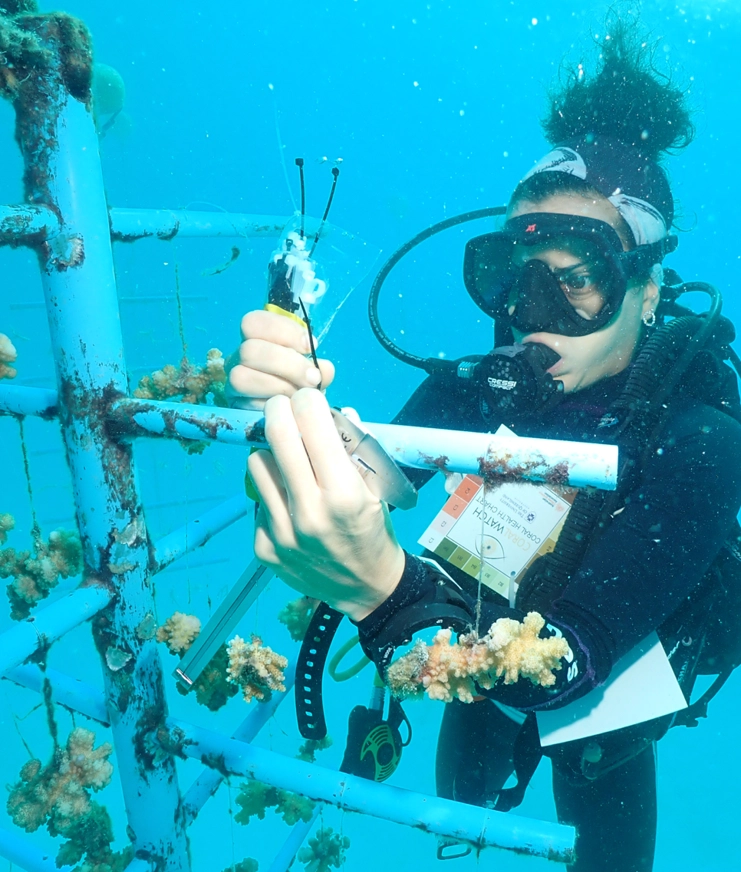The Good Traveler
A mental packing list of sorts, The Good Traveler lays out our aspirations on the path to becoming more respectful, considerate travelers. To learn how these ideas can shift and shape our journeys, we have invited ten travelers we admire to go into the world and explore each tenet.

Words Vidula KotianDate 19 April 2024
Currently, at her stint in Finolhu Baa Atoll Maldives, Ulloa is driving a coral reforestation project where the guests sponsor a tree. She and her diving team then plants the fragments onto the degraded reef once they have grown sufficiently. A firm believer that education is the key to shifting the mindset of the people, she holds weekly talks on the fascinating marine life surrounding Finolhu, coral reef preservation, and how “everything what we do everything has an effect on the sea.”
We chatted with this passionate diver about her journey to the sea, what tiny steps we could take to do better, and most of all, being mindful of how interact with nature.

Laura Ulloa, a Colombian marine biologist, is at the forefront of a coral restoration project at Finolhu Baa Atoll Maldives. Since her first dive in a pool, Ulloa has become a self-confessed deep-sea addict. She passionately advocates for mindful traveling, empowering Finolhu's guests with knowledge to make informed choices. As a marine life hero, she is dedicated to saving precious underwater life, one coral tree at a time.
I’m Colombian, from Bogotá, which is situated high up in the mountains at 2,600 meters above sea level. In my last year of university studying biology, my best friend approached me one day and said, “There’s a discount for a scuba diving course and we have to do it.” At the time, I was working on the research portion of my Bachelor’s studies and had to quit my bartending job because I didn’t have enough time to collect data. I told her I didn’t have the money or time, but she wouldn’t take no for an answer.
After two weeks of training in a diving pool, I knew my happiness lay in the water. My mom thought it was another one of my whims because I hadn’t even been in the actual sea yet. But I felt it, and here I am, 10 years later, still pursuing my passion. It also sparked the courage in me to talk to my marine biology professor about my desire to work in the field. He offered me a choice between two projects: working with fishermen in fisheries or on coral reef restoration at one of the national parks, both located in the Caribbean. Ninety percent of the reef was bleached and they were only a few units working on it. I chose coral reefs and never looked back.
In 2013, I landed a project in Bogotá as the lead marine biologist. After taking a free diving course, I realized that I needed to be in the blue. My sister suggested that I become an instructor instead of a free diver, considering my extensive experience in scuba diving and coral restoration. I ended up in Honduras, a tiny little island to become a dive instructor. However, in 2017, amid a big social uprising during the elections, Honduras closed its borders and imposed curfews. So, after a little over two years, I left. I posted on PADI’s employment board and got a job offer from the Maldives. My first time here was in 2018, and I have been coming and going ever since.
The Maldives experienced a massive coral bleaching event in 2016 due to El Niño’s heat. Corals, which live in symbiosis with algae, expel these algae under stressful conditions, leading to color loss and starvation. As a result, the corals weaken and die. With global warming, such events are becoming more frequent. Eighty-five percent of the Maldives’ islands reported bleaching, which is why it is mandatory for resorts to employ marine biologists to conduct coral research.
I joined Finolhu in June last year. Our general manager, Steven, is deeply passionate about nature. Our house reef, which is around two meters deep, looks like a graveyard due to coral degradation. However, deeper at the reef’s edge, the corals are healthier and booming with life. Our goal is to restore the top layer of the reef, covering one square kilometer, which will require more resources, a larger team, and significant funding over time.
Any guest can sponsor a coral tree. I educate them about corals, their importance, and threats. We then attach living coral fragments to a coral tree (a blue grid structure) at the dive center. These fragments grow in the nursery for nine months to a year. I monitor their health, using a coral chart (the darker the better), and send updates to the sponsor. After a year, or when the corals are as big as my hand, we transplant them onto the reef. This helps restore marine life. Our target is to establish at least 100 trees.

The coral trees in the nursery

At the edge of Finolhu's house reef
Thirty-six. What’s great is that the first 25% were set up all at once in the nursery, so the first generation will grow uniformly. For now, I must go to the reef to collect fragments. Once the first trees are big enough, I won’t need to go to the reef anymore.
Until I’ve fragmented the trees to produce new ones or have attached them to the natural reef, which takes about a year.
Not even all marine biologists fully understand corals. I find that explaining in simple terms really sparks interest. People are fascinated by corals, but few approach me on their own. I usually hold a couple of educational sessions each week, which guests need to prebook because we have to set up a screen.

Checking the health of the coral fragments in the nursery

Once the fragment has grown sufficiently, it is transplanted to the degraded reef

The coral chart's color wheel with the dark shades indicating optimal health
We need to trigger a mindset shift. I explain that whether we are high up in the mountains or deep in the continental land, whatever we do is interconnected. We need to think long term and go beyond what is just in front of us. For example, having plants in my office doesn’t impact the environment significantly, just as placing corals randomly is ineffective. Our efforts are like reforesting an area used for monoculture, which revitalizes marine life. The guests understand that a big part of what they come to see is because of corals. When we take them snorkeling, they understand that you cannot stand on the reef so as to protect key species. Many follow up on their coral tree, understanding that their impact can last thousands of years, forging a deep connection with nature.
Every choice matters, including the products you use like shampoo, sunscreen, and plastics. I advise against feeding fish to preserve their natural survival skills. Taking shells and corals as souvenirs disrupts their crucial role in the ecosystem; instead, take a photo and leave them be. For example, I once found a small coral and four shells weighing 116 grams in a staff member’s room. I explained that with 40% occupancy in year, if each guest took two shells, it would amount to over 4,000 shells and around 120 kilos of sand removed annually. Presenting these figures helps people understand the impact better.
I’ve also seen kids taking these little tiny crabs and putting them in boxes. Earlier the policy was that we couldn’t say anything to the guests. Now when I see kids doing that, I ask them to imagine being the crab and how they’d feel being confined in a box. Naturally, they wouldn’t like it. Also hermit crabs do not produce their own shell so every time that you take a shell with you, you’re leaving a crab without a shell. Without a shell, most of them die of dehydration as they search for another shell.
Think about how everything we do has an effect on the sea. So what tiny steps could we do better? Do we really need all the cosmetic products? How do we interact with nature?

The Maldives experienced a massive bleaching event in 2016
Collecting fragments for the nursery
The coral restoration project is in its second stage, meaning the fragments are still growing in the nursery and have not yet been outplanted onto the reef, so I cannot report any difference on the sea bed. However, the nursery (36 trees so far) has attracted marine life, such as emperors, goabies, surgeon, demselfish, and filefish. Previously, there was nothing there, although a reef-patch is close by. The location of the coral forest is a clear 9 meters deep.

Planting a coral tree
